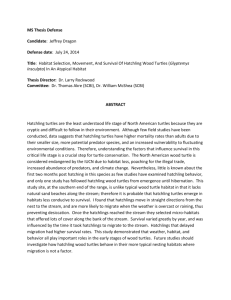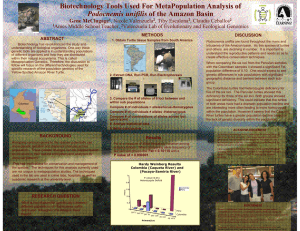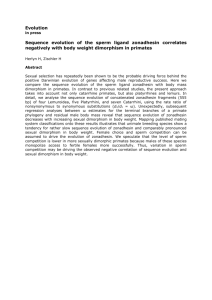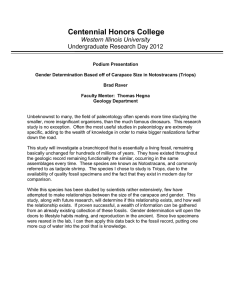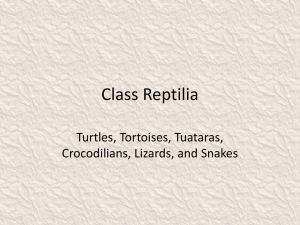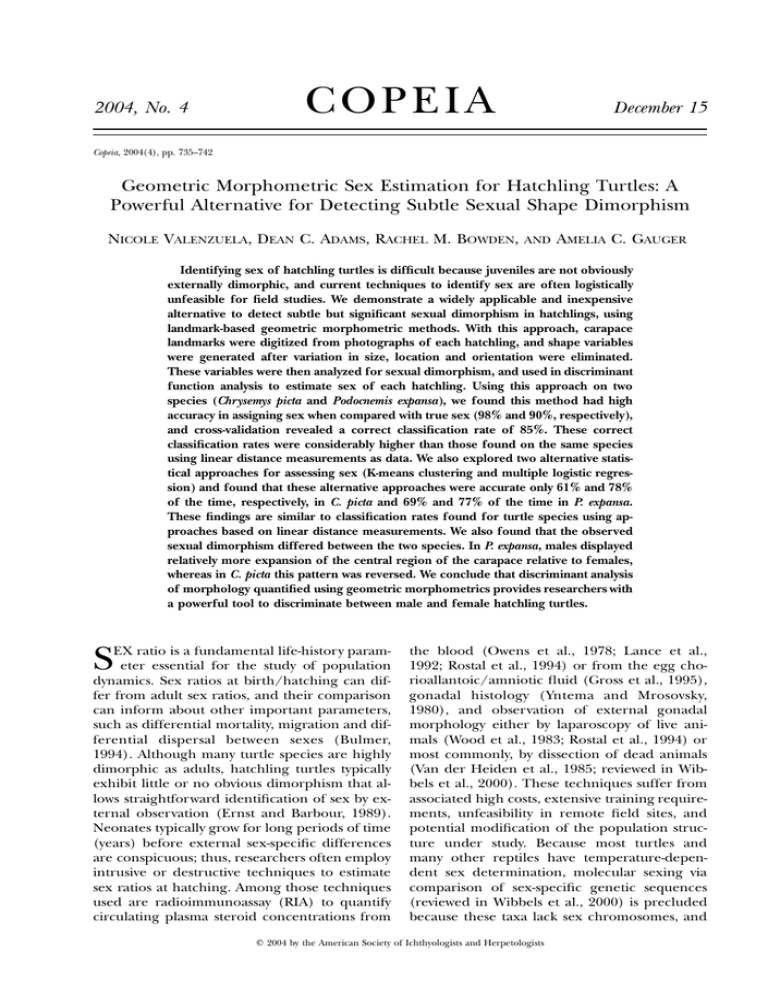
2004, No. 4
COPEIA
December 15
Copeia, 2004(4), pp. 735–742
Geometric Morphometric Sex Estimation for Hatchling Turtles: A
Powerful Alternative for Detecting Subtle Sexual Shape Dimorphism
NICOLE VALENZUELA, DEAN C. ADAMS, RACHEL M. BOWDEN,
AND
AMELIA C. GAUGER
Identifying sex of hatchling turtles is difficult because juveniles are not obviously
externally dimorphic, and current techniques to identify sex are often logistically
unfeasible for field studies. We demonstrate a widely applicable and inexpensive
alternative to detect subtle but significant sexual dimorphism in hatchlings, using
landmark-based geometric morphometric methods. With this approach, carapace
landmarks were digitized from photographs of each hatchling, and shape variables
were generated after variation in size, location and orientation were eliminated.
These variables were then analyzed for sexual dimorphism, and used in discriminant
function analysis to estimate sex of each hatchling. Using this approach on two
species (Chrysemys picta and Podocnemis expansa), we found this method had high
accuracy in assigning sex when compared with true sex (98% and 90%, respectively),
and cross-validation revealed a correct classification rate of 85%. These correct
classification rates were considerably higher than those found on the same species
using linear distance measurements as data. We also explored two alternative statistical approaches for assessing sex (K-means clustering and multiple logistic regression) and found that these alternative approaches were accurate only 61% and 78%
of the time, respectively, in C. picta and 69% and 77% of the time in P. expansa.
These findings are similar to classification rates found for turtle species using approaches based on linear distance measurements. We also found that the observed
sexual dimorphism differed between the two species. In P. expansa, males displayed
relatively more expansion of the central region of the carapace relative to females,
whereas in C. picta this pattern was reversed. We conclude that discriminant analysis
of morphology quantified using geometric morphometrics provides researchers with
a powerful tool to discriminate between male and female hatchling turtles.
S
EX ratio is a fundamental life-history parameter essential for the study of population
dynamics. Sex ratios at birth/hatching can differ from adult sex ratios, and their comparison
can inform about other important parameters,
such as differential mortality, migration and differential dispersal between sexes (Bulmer,
1994). Although many turtle species are highly
dimorphic as adults, hatchling turtles typically
exhibit little or no obvious dimorphism that allows straightforward identification of sex by external observation (Ernst and Barbour, 1989).
Neonates typically grow for long periods of time
(years) before external sex-specific differences
are conspicuous; thus, researchers often employ
intrusive or destructive techniques to estimate
sex ratios at hatching. Among those techniques
used are radioimmunoassay (RIA) to quantify
circulating plasma steroid concentrations from
the blood (Owens et al., 1978; Lance et al.,
1992; Rostal et al., 1994) or from the egg chorioallantoic/amniotic fluid (Gross et al., 1995),
gonadal histology (Yntema and Mrosovsky,
1980), and observation of external gonadal
morphology either by laparoscopy of live animals (Wood et al., 1983; Rostal et al., 1994) or
most commonly, by dissection of dead animals
(Van der Heiden et al., 1985; reviewed in Wibbels et al., 2000). These techniques suffer from
associated high costs, extensive training requirements, unfeasibility in remote field sites, and
potential modification of the population structure under study. Because most turtles and
many other reptiles have temperature-dependent sex determination, molecular sexing via
comparison of sex-specific genetic sequences
(reviewed in Wibbels et al., 2000) is precluded
because these taxa lack sex chromosomes, and
䉷 2004 by the American Society of Ichthyologists and Herpetologists
736
COPEIA, 2004, NO. 4
no consistent genetic differences are known to
exist between males and females (Valenzuela et
al., 2003).
An alternative to the above approaches is to
use a sensitive morphometric technique for detecting subtle differences between hatchling
males and females that are not noticeable to the
naked eye. Typically, sets of linear distance measurements are obtained for each specimen, and
statistical methods are used to attempt to discriminate males and females using these characteristics. This technique has been used successfully to identify hatchlings of the Olive Ridley Sea Turtle (Lepidochelys olivacea; Michel-Morfin et al., 2001). Unfortunately, similar attempts
have proven unsuccessful for hatchlings of other species, including Podocnemis expansa (Hildebrand et al., 1997) and several chelonians (e.g.,
Gopherus agassizii; Burke et al., 1994; Boone and
Holt, 2001). For instance, Hildebrand et al.
(1997) analyzed 159 P. expansa hatchlings using
25 morphological characters, such as the length
and width of the carapace, plastron, tail, limb,
head, and the number of limb scales. They
found no difference between males and females
in these characteristics (P ⬎ 0.8), and using
these data, fewer than 78% of the specimens
could be correctly classified to sex. Podocnemis
expansa is a tropical endangered freshwater turtle belonging to the chelonian suborder Pleurodira, and sex has been determined nonlethally using radioimmunoassay (Lance et al.,
1992; Valenzuela et al., 1997; Valenzuela, 2001),
but because of the difficulties mentioned above,
this technique is not commonly used by researchers. Therefore, a more sensitive method
using morphology is sorely needed.
Developing a method for sex estimation of
hatchlings from morphology requires two important considerations. The first is choosing the
best method for quantifying morphology, and
the second is determining the most suitable statistical approach for analyzing these data. Here
we show that quantifying morphology using
geometric morphometric (GM) methods is a
feasible and inexpensive approach based on external morphological characteristics, which can
successfully detect sexual dimorphism in hatchlings of P. expansa, where other morphological
techniques have failed. Additionally, GM methods allow the classification of hatchlings into sex
categories with high accuracy. We also explore
various statistical methods for estimating differences between males and females based on
these characteristics and show that linear discriminant analysis is the most useful approach.
We present an identical analysis in another turtle species, Chrysemys picta, a widely distributed
Fig. 1. Podocnemis expansa hatchling illustrating the
location of the 30 landmarks used in this study. For
statistical analyses, only landmarks on the right-half of
the carapace were used.
temperate freshwater turtle representing the
other suborder of chelonians (Criptodira).
MATERIALS
AND METHODS
Specimens.—Hatchlings of P. expansa were collected from a population along the Caquetá River in Colombia. They were also used during a
previous study of sex determination in the field
and laboratory and correspond to several natural and experimental nests differing in depth,
shading, and temperature conditions (Valenzuela, 2001). All P. expansa specimens used for
this study were 1–2 weeks old. Chrysemys picta
eggs were collected in June 2001 from a population that nests on the northern end of an island in the Mississippi River near Thomson, Illinios. Once collected, eggs were brought to a
laboratory at Iowa State University and placed
into plastic boxes containing moist vermiculite
(-150 kPa) for incubation. Eggs were incubated
at a constant temperature (28 C), and the boxes
were rotated regularly to minimize any effects
of thermal gradients within the incubator. A total of 230 P. expansa and 87 C. picta hatchlings
were photographed at ⬍ 2 weeks and ⬃2
months of age, respectively (Fig. 1). All of these
hatchlings presented a normal number of
scutes and had fully unfolded after hatching.
Hatchlings were sexed by radioimmunoassay (P.
expansa; Valenzuela, 2001) or by macroscopic
examination of gonadal morphology after dissection (C. picta; Ewert and Nelson, 1991; Bowden et al., 2000).
Data collection and analysis.—Developing a method for sex estimation of hatchlings from morphology requires two important considerations.
The first is choosing the best method for quan-
VALENZUELA ET AL.—GM SEXING OF HATCHLING TURTLES
tifying morphology, and the second is determining the most suitable statistical approach for analyzing these data. Previous work has shown that
linear distance measures have had only limited
success in distinguishing hatchling males and females (e.g., Michel-Morfin et al., 2001). Therefore, we used an alternative approach and quantified morphology from the positions of biologically repeatable (operationally homologous)
anatomical points, which were then subjected to
a geometric morphometric (GM) analysis. GM
methods quantify the shape of an object after
the effects of nonshape variation (position, orientation, and scale) have been mathematically
held constant (Rohlf and Slice, 1990). These
methods are preferable to linear distance methods because they retain the geometry of shape
throughout the analysis (Rohlf and Marcus,
1993). Additionally, when compared to other
approaches (including linear distance methods), simulation studies have shown that Procrustes-based GM methods outperform other
approaches and have higher statistical power,
appropriate type I error rates, low bias and error of estimating mean shapes, and do not introduce patterns of covariation to the data (see
Rohlf, 1995, 2000a,b, 2003). Therefore, when
compared to linear distance methods, quantifying morphological shape using landmarkbased GM approaches will provide the best opportunity to capture subtle differences between
male and female hatchlings.
For our analyses we quantified carapace
shape in the following manner. First, digital images of the carapace of each specimen were obtained using a Nikon DXM-1200 high-resolution
digital camera (C. picta) or by scanning highresolution slide color photographs (P. expansa).
For all images, a ruler was included for scale.
From each image, the x,y coordinates of 30 anatomical landmarks (Fig. 1) were then recorded
using TpsDig software (F. J. Rohlf, unpubl.).
The landmarks included the intersections of the
lines delineating the vertebral and the marginal
scutes, as well as the perimeter of the carapace
at the boundary between the first and second
marginals (anterior) and between the 11th and
12th marginals (posterior). For shape analyses,
16 landmarks from the right half of each carapace were subjected to a Generalized Procrustes
Analysis (GPA), to superimpose the specimens
to a common coordinate system, and mathematically remove the effects of digitizing position, orientation, and scale (Rohlf and Slice,
1990). Half of the carapace was used to generate shape variables because use of landmarks
obtained from both sides of a symmetric object
(e.g., a carapace) generates linear dependen-
737
cies among shape variables that cause statistical
difficulties (for a discussion see Bookstein,
1996a). For graphical depictions of results however, all 30 landmarks were used to facilitate biological interpretation. From the aligned specimens, a total of 28 shape variables were calculated, as partial warp scores from the thin-plate
spline (Bookstein, 1989, 1991) and the two standard uniform components (Bookstein, 1996b;
Rohlf and Bookstein, 2003). These variables describe the shape change necessary to transform
the landmark coordinates of the mean specimen to the locations of the landmarks for that
particular specimen. Together, they capture the
linear and nonlinear aspects of shape variation
and can be used to test hypotheses of shape variation and covariation within and among groups
using standard multivariate statistical procedures (see e.g., Caldecutt and Adams, 1998; Adams and Rohlf, 2000; Rüber and Adams, 2001).
All superimposition and thin-plate spline computations for generating morphometric shape
variables were performed in TPSRelw (F. J.
Rohlf, unpubl.).
Using the shape data described above, morphological variation was assessed in several ways.
First we performed a two-factor multivariate
analysis of variance (MANOVA) to determine
whether there were differences in carapace
shape between species, between the sexes (i.e.,
sexual dimorphism), and to determine whether
sexual dimorphism was consistent between the
species. We then assessed sexual dimorphism
for each species individually by performing
MANOVA separately on each species. To estimate the sex of hatchlings, we used three statistical methods and examined their performance
by comparing the percent of hatchlings whose
estimated sex correctly matched their true sex
(i.e., the percent correct classification). The
first approach was K-means clustering. With this
approach, a set of specimens are partitioned
into K-groups such that the objects within the
K-groups are more similar to one another than
objects in the other clusters, thereby minimizing within-group variation (Wong and Lane,
1983; Legendre and Legendre, 1998). One can
then assess how well the specimens partitioned
into two groups correspond to the two sexes.
This approach is closest in spirit to what is desired when biologists ask, ‘‘How many groups
are present in my data?’’ The second approach
was multiple logistic regression. Here the set of
shape variables were treated as independent variables, and sex was the dependent variable. The
third approach was discriminant function analysis (DFA). Here the set of shape variables were
treated as independent variables, and a multi-
738
COPEIA, 2004, NO. 4
TABLE 1. RESULTS TWO-FACTOR MANOVA COMPARING CARAPACE SHAPE BETWEEN SPECIES
Source
Exact F
Species
Sex
Species ⫻ Sex
172.1083
1.9037
1.5758
variate equation (function) was defined such
that males and females were maximally discriminated.
Using each of the three approaches, sex was
estimated for each hatchling, and the overall
correct classification rate was observed by contrasting the estimated sex with the true sex (as
assigned by RIA or gonadal inspection). These
values were qualitatively compared to examine
the relative performance of the three statistical
approaches in estimating hatchling sex. Additionally, because classification rates can be inflated when the same specimens are used to
generate the DFA and assess its classification
rate (see Krzanowski, 1988), we performed a
cross-validation analysis. For this analysis, 20
specimens (10 males and 10 females) of P. expansa were excluded from the dataset, the discriminant function was obtained for the remaining specimens, and the sex of the 20 excluded
hatchlings were estimated using the discriminant function. The 20 excluded specimens were
then used to assess the DFA classification rate
by comparing their estimated sex to their true
sex (as found by RIA). Smaller sample size precluded a similar cross-validation procedure for
C. picta. Finally, to visualize sexual dimorphism,
we generated graphical representations of
shape for males and females along the discriminant axis using thin-plate spline deformation
grids. These plots are analogous to D’Arcy
Thompson’s (1917) transformation grids and
provide a graphical representation of shape difference among groups. All statistical analyses
were performed using NTSYS-pc (F. J. Rohlf,
unpubl.) and JMP 5.0.1 (SAS Institute, unpubl.).
RESULTS
Examining carapace shape variation using a
two-factor MANOVA, we found significant effects for species, sex, and species by sex interaction (Table 1). This implied that P. expansa
and C. picta differ in carapace shape, that there
is significant sexual dimorphism of carapace
shape, and that the sexual dimorphism in shape
is not consistent between the two species. When
the two species were examined separately, sig-
df
27, 287
27, 287
27, 287
AND BETWEEN THE
SEXES.
P
⬍0.0001
0.0005
0.0104
nificant sexual dimorphism was confirmed (P.
expansa: exact F ⫽ 3.39, df ⫽ 27,202, P 0.00001;
C. picta: exact F ⫽ 1.63, df ⫽ 27,59, P ⫽ 0.07).
When comparing sex estimation methods, we
found that discriminant analysis greatly outperformed alternative techniques. Using K-means
clustering, we found that 69% of P. expansa
hatchlings and 61% of C. picta hatchlings were
correctly classified. Multiple logistic regression
performed slightly better, correctly classifying
77% and 78% of the hatchling turtles, respectively. Using DFA, however, posthoc classification revealed an extremely high degree of separation of the two sexes. For P. expansa, 90%
(207 of 230) of the individuals were classified to
the correct sex, and for C. picta, 98% (85 of 87)
of the individuals were classified to the correct
sex. When cross-validation analysis was performed for P. expansa, the classification rate of
the included specimens was identical (90%),
and that of the specimens excluded from the
analysis was 85% (17 of 20).
To describe the sexual dimorphism visually,
we generated graphical representations of
shape for males and females along the discriminant axis for each species using thin-plate
spline deformation grids, such that anatomical
differences between the sexes could be assessed.
Using this approach, differences in carapace
shape between species, as well as the different
sexual dimorphism in each species, were evident (Fig. 2). When comparing the species, the
most noticeable differences were in the cranial
region of the carapace, where there was more
flaring of these scutes in C. picta, and more relative compression of this region in P. expansa
(Fig. 2). With respect to sexual dimorphism,
both species exhibited differences in the anal
region of the carapace, which was more flared
in males and relatively more compressed in females. Additionally, males and females differed
in the central vertebral region, although the
male-female pattern was in the opposite direction for the two species. In P. expansa, males displayed relatively more expansion of the central
region of the carapace relative to females,
whereas in C. picta this pattern was reversed
(Fig. 2). This provided graphical confirmation
that the sexual dimorphism in carapace shape
VALENZUELA ET AL.—GM SEXING OF HATCHLING TURTLES
739
Fig. 2. Thin-plate spline deformation grids representing the mean shape of (A) male Podocnemis expansa
(B) female P. expansa (C) male Chrysemys picta and (D) female C. picta, as found along the discriminant function
axis between sexes (grids are displayed at 3⫻ magnification to emphasize group differences). Orientation is
as in Figure 1 with the head of the animals to the right. Solid gray ovals highlight regions of the carapace with
significant differences between the sexes, whereas dashed black ovals denote regions were significant differences between species were more pronounced.
was present in both species but was not consistent between them.
DISCUSSION
Because the sex of hatchlings of most turtle
species are not identifiable by the naked eye, a
more sophisticated method is required to distinguish males from females. When morphology is
used, it is logical that one quantifies morphology using the most powerful and sensitive approach possible. Computer simulations have
shown that shape data from geometric morphometric methods have higher power, better type
I error rates, lower bias, and lower mean
squared error when compared to variables generated from sets of linear distances (Rohlf,
1999, 2000a,b, 2003). Therefore, from a theoretical perspective, GM methods are preferable
to distance methods for morphological quantification. Furthermore, these methods are quite
powerful in discriminating male and female
hatchling turtles. In our study, we found higher
correct classification rates than are typically
found using sets of linear distance measures,
and these results were consistent for two turtle
species of different suborders. One of these species (P. expansa) also has been examined using
more traditional methods of DFA on a set of
linear distances, and this method was not able
to distinguish male and female hatchlings (Hildebrand et al., 1997). Therefore, a direct comparison of two methods for quantifying morphology on the same species has revealed that
the GM protocol is capable of identifying subtle
morphological dimorphism between the sexes
that linear distances could not.
In this study, we were able to reveal significant
sexual dimorphism in the external morphology
of both P. expansa and C. picta hatchlings, a dimorphism that was undetected using other morphometric techniques (Hildebrand et al., 1997).
This technique is not species-specific and is expected to be widely applicable because it was
implemented with equal success in two highly
divergent species. Second, this methodology
740
COPEIA, 2004, NO. 4
proved to be a suitable tool to estimate the sex
of hatchlings with high accuracy, thus providing
researchers with a noninvasive and inexpensive
alternative to current sexing techniques. However, some words of caution are in order. As
field biologists, we desire a simple and straightforward technique that enables us to quickly
identify male and female hatchlings using only
a few measurements with little or no uncertainty. Unfortunately, no such method exists. First,
it must be recognized that all existing methods
except inspection of gonadal histology are little
more than methods of sex estimation, rather
than being methods of true sex identification.
Therefore, all methods require empirical validation by comparing the estimated sex to the
sex confirmed through gonadal inspection, at
least for a subset of individuals. Second, even
when a sex estimation method is found to be
useful for a given population, extrapolation of
its use to other populations and species is ill
advised, even when the resulting sexual dimorphism is similar between species. Further, because all existing methods for sex estimation are
data dependent, use of a different set of hatchings will result in a slightly (or greatly) different
sex estimation function. Therefore, treating the
resulting discriminant functions as sex estimation ‘‘rules’’ to be applied to other data (and to
be compared among species) is tenuous at best,
because they are not generalizeable beyond the
data for which they were optimized. Only
through empirical evaluation in additional populations (both geographic and generational)
can it be determined whether a particular discriminant function is useful for additional samples of the same species. If the same (or similar)
discriminant function is obtained for data from
multiple populations, and across multiple years,
this implies that hatchling sexual dimorphism is
consistent within a particular species. To our
knowledge, this has never been empirically
demonstrated for any sex identification rule
based on morphology.
Although significant, the difference in shape
between males and females found in this study
are subtle enough to pass undetected to the naked eye, hence requiring sensitive geometric
morphometric techniques for sex estimation.
Additionally, we failed to find a subset of diagnostic linear measurements that captured the
essence of the variation in the regions of the
carapace that changed the most between males
and females, as determined by the geometric
morphometric analysis (results not shown). This
indicates that, although changes in parts of the
carapace eliminated during the search for diagnostic cues were smaller, they are fundamen-
tal components of the overall shape dimorphism between the sexes, such that they cannot
be removed without losing the dimorphic signal. This may also explain why previous discriminant analysis using distance measurements
have been unsuccessful in P. expansa (Hildebrand et al., 1997).
The higher level of misclassification in the
case of P. expansa compared to C. picta may be,
in part, caused by the potential error associated
with the radioimmunoassay itself. That is, if
some individuals were misclassified by the RIA,
they will appear in the ‘‘incorrect’’ sex category
using morphometrics. The classification error
may be smaller in C. picta because hatchlings
were sexed by gonadal inspection. However, the
RIA technique, as originally standardized for P.
expansa, gave a 100% match to true sex as determined by histology (Lance et al., 1992).
Thus, an alternative explanation is that, although shape differences appear evident for P.
expansa, male and female hatchlings exhibit a
larger overlap in shape space that results in a
higher misclassification rate when compared to
C. picta.
Finally, the biological significance of the pattern of sexual dimorphism in shape detected in
either of these two species remains unclear.
Only one other turtle species has been examined with GM methods, Trachemys scripta (Slice,
1993), to study the pattern of sexual dimorphism in adults, and a somewhat similar but not
fully consistent pattern was found to that detected in hatchlings of P. expansa. The carapace
of female T. scripta is centrally deeper, anteriorly
broader, and posteriorly narrower, with a more
laterally contracted midregion than the carapace of males (Slice, 1993). In many other chelonian species, one main adult dimorphic characteristic is the higher domed carapace of females relative to males (Ernst and Babour,
1989). However, direct shape comparisons with
our results or those of Slice (1993) await future
study because, to our knowledge, the sexual dimorphism of no other taxa have yet been examined with GM methods. One could speculate
that the dimorphisms detected in this study may
be a functional difference linked to reproduction. For example, females may be more constrained laterally in the midregion to produce a
more domed carapace associated with larger abdominal volume for egg carrying, and the wider
posterior end may also facilitate the passage of
eggs during oviposition. Consistent with this
idea, a flatter carapace constrains the clutch size
of female Natator depressa when compared to females of similar size from other Cheloniidae
species (Hays, 2001). However, it is difficult to
VALENZUELA ET AL.—GM SEXING OF HATCHLING TURTLES
reconcile our results with this hypothesis because, although female P. expansa exhibited the
more laterally constrained midregion, C. picta
females did not, and males in both species displayed the wider posterior end relative to females.
The dimorphism we found was subtle in both
species, but significant sexual dimorphism in
adults can also be subtle. Slice (1993) suggested
that, as detected for adult T. scripta, important
sexual differences can result from slight shape
differences, small in magnitude as compared to
overall shape variation, but related to reproductive function directly or indirectly. More important, the onset of sexual dimorphism of a different trait related to reproduction of adult Chelydra serpentina (namely, precloacal length) is
known to be as early as hatching (de Solla et
al., 2002). Thus, our finding of a carapace shape
dimorphism in C. picta and P. expansa at such
an early life stage may not be completely unexpected. The biological significance of such dimorphism, however, remains an open question.
ACKNOWLEDGMENTS
This work was sponsored in part by National
Science Foundation (NSF) grant DEB-0122281
(to DCA). Chrysemys picta eggs used in this study
were collected under scientific collecting permit
NH-01.0073 from the Illinois DNR and a
USFWS Special Use Permit 32576-01017. Use of
C. picta hatchlings was covered under ISU Animal Care Protocol 1-1-4733-J. Support for RMB
was provided by NSF grant DEB-0089680.
LITERATURE
CITED
ADAMS, D. C., AND F. J. ROHLF. 2000. Ecological character displacement in Plethodon: biomechanical differences found from a geometric morphometric
study. Proc. Natl. Acad. Sci. USA 97:4106–4111.
BOOKSTEIN, F. L. 1989. Principal warps: thin-plate
splines and the decomposition of deformations.
IEEE Trans. Patt. Anal. Mach. Intell. 11:567–585.
———. 1991. Morphometric tools for landmark data:
geometry and biology. Cambridge Univ. Press,
Cambridge.
———. 1996a. Combining the tools of geometric
morphometrics, p. 131–151. In: Advances in morphometrics. L. F. Marcus, M. Corti, A. Loy, G. Naylor, and D. Slice (eds.). Plenum Press, New York.
———. 1996b. A standard formula for the uniform
shape component, p. 153–168. In: Advances in morphometrics. L. F. Marcus, M. Corti, A. Loy, G. Naylor, and D. Slice (eds.). Plenum Press, New York.
BOONE, J. L., AND E. A. HOLT. 2001. Sexing young
free-ranging desert tortoises (Gopherus agassizii) using external morphology. Chel. Conserv. Biol. 4:28–
33.
741
BOWDEN, R. M., M. A. EWERT, AND C. E. NELSON. 2000.
Environmental sex determination in a reptile varies
seasonally and with yolk hormones. Proc. R. Soc.
Lond. B Biol. Sci. 267:1745–1749.
BULMER, M. 1994. Theoretical evolutionary ecology.
Sinauer Associates, Inc., Sunderland, MA.
BURKE, R. L., E. R. JACOBSON, M. J. GRIFFITH, AND L.
J. GUILLETTE. 1994. Non-invasive sex identification
of juvenile gopher and desert tortoises (genus Gopherus). Amphib.-Reptilia 15:183–189.
CALDECUTT, W. C., AND D. C. ADAMS. 1998. Morphometrics of trophic osteology in the Threespine
Stickleback, Gasterosteus aculeatus. Copeia 1998:827–
838.
DE SOLLA, S. R., C. A. BISHOP, AND R. J. BROOKS. 2002.
Sexually dimorphic morphology of hatchling Snapping Turtles (Chelydra serpentina) from contaminated and reference sites in the Great Lakes and St.
Lawrence River basin, North America. Environ.
Toxicol. Chem. 21:922–929.
ERNST, C. H., AND R. W. BARBOUR. 1989. Turtles of the
world. Smithsonian Institution Press, Washington,
DC.
EWERT, M. A., AND C. E. NELSON. 1991. Sex determination in turtles: diverse patterns and some possible adaptive values. Copeia 1991:50–69.
GROSS, T. S., D. A. CRAIN, K. A. BJORNDAL, A. B. BOLTEN, AND R. R. CARTHY. 1995. Identification of sex
in hatchling Loggerhead Turtles (Caretta caretta) by
analysis of steroid concentrations in chorioallantoic/amniotic fluid. Gen. Comp. Endocrin. 99:204–
210.
HAYS, G. C. 2001. The implications of adult morphology for clutch size in the Flatback Turtle (Natator
depressa). J. Mar. Biol. Assoc. U.K. 81:1063–1064.
HILDEBRAND, V. P., N. BERMÚDEZ, AND M. C. PEÑUELA.
1997. La tortuga charapa (Podocnemis expansa) en el
rı́o Caquetá, Amazonas, Colombia. Aspectos de su
biologı́a reproductiva y técnicas para su manejo.
Disloque Editores, Santafé de Bogotá, Colombia.
KRZANOWSKI, W. J. 1988. Principles of multivariate
analysis: a user’s perspective. Oxford Scientific Publications, Clarendon Press, Oxford.
LANCE, V. A., N. VALENZUELA, AND P. VON HILDEBRAND.
1992. A hormonal method to determine sex of
hatchling giant river turtles, Podocnemis expansa: application to endangered species. J. Exp. Zool. 270:
16A.
LEGENDRE, P., AND L. LEGENDRE. 1998. Numerical ecology. 2d ed. Elsevier, Amsterdam, The Netherlands.
MICHEL-MORFIN, J. E., V. M. GÓMEZ MUÑOZ, AND C.
NAVARRO RODRı́GUEZ. 2001. Morphometric model
for sex assessment in hatchling olive Ridley Sea Turtles. Chel. Conserv. Biol. 4:53–58.
OWENS, D. W., J. R. HENDRICKSON, V. A. LANCE, AND I.
P. CALLARD. 1978. A technique for determining sex
of immature Chelonia mydas using radioimmunoassay. Herpetologica 34:270–273.
ROHLF, F. J. 1995. Multivariate analysis of shape using
partial-warp scores, p. 154–158. In: Proceedings in
current issues in statistical shape analysis, K. V. Mardia and C. A. Gill (eds.). Univ. of Leeds, Leeds,
U.K.
742
COPEIA, 2004, NO. 4
———. 2000a. On the use of shape spaces to compare
morphometric methods. Hystrix 11:9–25.
———. 2000b. Statistical power comparisons among
alternative morphometric methods. Am. J. Phys.
Anthropol. 111:463–478.
———. 2003. Bias and error in estimates of mean
shape in geometric morphometrics. J. Hum. Evol.
44:665–683.
———, AND F. L. BOOKSTEIN. 2003. Computing the
uniform component of shape variation. Syst. Biol.
52:66–69.
———, AND L. F. MARCUS. 1993. A revolution in morphometrics. Trends Ecol. Evol. 8:129–132.
———, AND D. E. SLICE. 1990. Extensions of the Procrustes method for the optimal superimposition of
landmarks. Syst. Zool. 39:40–59.
ROSTAL, D. C., J. S. GRUMBLES, V. A. LANCE, AND J. R.
SPOTILA. 1994. Non-lethal sexing techniques for
hatchling and immature Desert Tortoises (Gopherus
agassizii). Herpetol. Monogr. 8:72–82.
RÜBER, L., AND D. C. ADAMS. 2001. Evolutionary convergence of body shape and trophic morphology in
cichlids from Lake Tanganyika. J. Evol. Biol. 14:
325–332.
SLICE, D. E. 1993. Extensions, comparisons, and application of superimposition methods for morphometric analysis. Unpubl. Ph.D. diss., State Univ. of
New York, Stony Brook.
THOMPSON, D. W. 1917. On growth and form. Cambridge Univ. Press, London.
VALENZUELA, N. 2001. The effects of constant, shift
and naturally-fluctuating temperature on sex-determination in Podocnemis expansa turtles. Ecology 82:
3010–3024.
———, R. BOTERO, AND E. MARTı́NEZ. 1997. Field
study of sex determination in Podocnemis expansa
from Colombian Amazonia. Herpetologica 53:390–
398.
———, D. C. ADAMS, AND F. J. JANZEN. 2003. Pattern
does not equal process: exactly when is sex environmentally determined? Am. Nat. 161:676–683.
VAN DER HEIDEN, A. M., R. BRISEÑO-DUEÑAS, AND D.
RIOS-OLMEDA. 1985. A simplified method for determining sex in hatchling sea turtles. Copeia 1985:
779–782.
WIBBELS, T., D. W. OWENS, AND C. J. LIMPUS. 2000.
Sexing juvenile sea turtles: is there an accurate and
practical method? Chel. Conserv. Biol. 3:756–761.
WONG, M. A., AND T. LANE. 1983. A kth nearest neighbor clustering procedure. J. R. Stat. Soc. Ser. B Biol.
Sci. 45:362–368.
WOOD, J. R., F. E. WOOD, K. H. CRITCHLEY, D. E.
WILDT, AND M. BUSH. 1983. Laparoscopy on the
Green Sea Turtle, Chelonia mydas. Brit. J. Herpetol.
6:323–327.
YNTEMA, C. L., AND N. MROSOVSKY. 1980. Sexual differentiation in hatchling loggerheads (Caretta caretta) incubated at different controlled temperatures. Herpetologica 36:33–36.
(NV, DCA) DEPARTMENT OF ECOLOGY, EVOLUTION, AND ORGANISMAL BIOLOGY, IOWA STATE
UNIVERSITY, AMES, IOWA 50011; (RMB) DEPARTMENT OF BIOLOGICAL SCIENCES, ILLINOIS
STATE UNIVERSITY, NORMAL, ILLINOIS 61790;
AND (ACG) GILBERT HIGH SCHOOL, GILBERT,
IOWA 50105. E-mail: (Nv) nvalenzu@iastate.
edu. Send reprint requests to NV. Submitted:
16 Oct. 2003. Accepted: 17 May 2004. Section
editor: M. E. Douglas.

